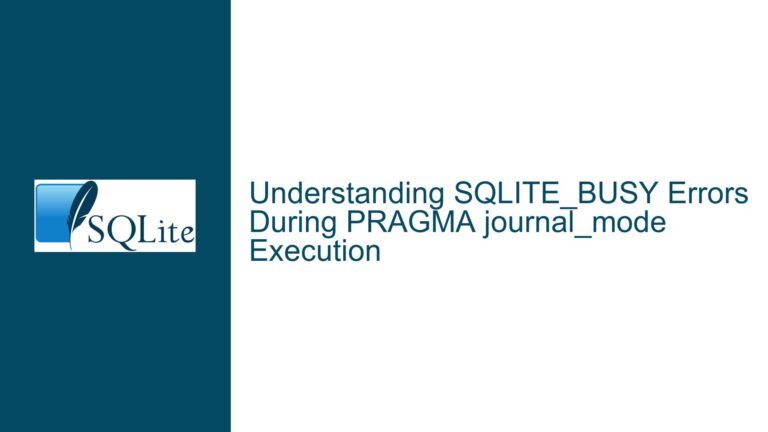Reducing SQLite Library Size for Embedded Systems: Optimization Strategies and Compilation Techniques
Understanding SQLite Library Size Expectations in Embedded Environments
The primary challenge revolves around achieving a minimal SQLite library footprint for resource-constrained embedded devices like IP cameras. Developers often encounter discrepancies between documented size claims (e.g., "under 300KiB with features disabled") and actual compiled binary sizes, particularly when transitioning from 32-bit x86 to 64-bit architectures. The SQLite documentation historically cited sizes under 500KiB for full-featured builds on ix86 platforms, but modern versions and 64-bit targets exhibit larger footprints due to expanded functionality and architectural changes. For example, SQLite 3.45.0 compiled with GCC 5.4.0 on x86_64 Linux with -Os produces a ~663KiB library, while embedded builds targeting ARMv7 may see variations based on toolchain optimizations.
Three critical factors create this gap:
- Architectural Differences: 64-bit instruction sets inherently require more space for pointer storage and alignment, increasing binary size by 20-30% compared to 32-bit equivalents.
- Feature Inflation: New SQLite versions introduce functionalities like JSON1, window functions, and enhanced security that expand code size.
- Toolchain Evolution: Modern compilers prioritize execution speed over binary compactness unless explicitly configured for size optimization.
Embedded use cases demanding only basic CRUD operations (INSERT/SELECT/WHERE) can theoretically achieve sub-300KiB sizes through aggressive feature stripping. However, developers must reconcile these goals with SQLite’s growing codebase and platform-specific compiler behaviors.
Factors Contributing to Increased SQLite Binary Size
Target Architecture and Data Model Mismatch
The original SQLite size benchmarks referenced 32-bit x86 architectures, where 4-byte pointers and compact instruction encoding yield smaller binaries. When compiling for x86_64 or ARM64, 8-byte pointers widen memory structures and expand function prologues/epilogues. For instance, a simple pointer dereference operation consumes twice the space in 64-bit mode. Embedded Linux toolchains often enable Position-Independent Code (PIC) by default for shared libraries, adding relocation metadata that bloats binaries by 5-10%.
Unoptimized Feature Inclusion
SQLite’s amalgamated build includes all core components by default, including parser generators, virtual tables, and extension frameworks. Common size offenders:
- JSON1 Extension: Adds ~45KiB
- Full Text Search (FTS): Contributes ~120KiB across FTS3/4/5
- R*Tree Module: ~22KiB
- Undocumented Debug Utilities: Assertions and logging add ~15KiB
Even with OMIT directives, residual dependencies may persist. For example, disabling FTS (SQLITE_OMIT_FTS3) still leaves hook functions in parse.y that reference tokenizer components unless SQLITE_OMIT_FTS4/5 are also specified.
Suboptimal Compiler Configuration
GCC’s -Os flag enables basic size optimizations like avoiding loop unrolling and reducing alignment padding. However, it doesn’t activate advanced techniques like function reordering for cache locality or aggressive inlining heuristics. Clang’s -Oz goes further by collapsing tail calls and sacrificing debuggability, potentially trimming another 8-12% compared to GCC. Cross-compilation toolchains for MIPS or ARMv5 often lack these optimizations unless explicitly configured.
Measurement Methodology Errors
Developers frequently measure the entire application binary (e.g., test_sqlite) instead of isolating the library’s contribution. A minimal CLI shell with basic .open and .tables commands adds ~85KiB, while static linking against musl libc instead of glibc saves ~30KiB. Shared library builds introduce external dependencies that inflate disk usage but reduce memory footprint through dynamic loading.
Effective Methods for Minimizing SQLite Library Footprint
Step 1: Baseline Establishment and Component Audit
Extract the SQLite library’s exact contribution using size analysis tools:
# For static libraries
ar x libsqlite3.a
size *.o | awk '{text += $1; data += $2; bss += $3} END {print text+data+bss}'
# For shared objects
objdump -h libsqlite3.so | grep -E '\.text|\.data|\.rodata' | awk '{sum += $3} END {print sum}'
Compare against known configuration profiles using the SQLite compilation dashboard (sqlite.org/sizedash). Disable non-essential subsystems via a custom sqlite_custom.h header:
#define SQLITE_OMIT_ALTERTABLE 1
#define SQLITE_OMIT_AUTOINIT 1
#define SQLITE_OMIT_DEPRECATED 1
#define SQLITE_OMIT_LOAD_EXTENSION 1
#define SQLITE_OMIT_PROGRESS_CALLBACK 1
#define SQLITE_OMIT_SHARED_CACHE 1
#define SQLITE_MAX_ATTACHED 2 // Reduce handle storage
Step 2: Toolchain and Optimization Flag Tuning
Replace GCC with Clang 16+ and apply machine-specific optimizations:
CC=clang CFLAGS="-Oz -flto -march=armv7-a -mtune=cortex-a9 -fomit-frame-pointer" ./configure
Key flags:
- -Oz: Aggressive size optimization (Clang exclusive)
- -flto: Link-Time Optimization removes dead code across translation units
- -fno-unwind-tables: Disables exception handling metadata (~3% savings)
- -fno-asynchronous-unwind-tables: Removes stack unwinding data
For GCC builds, append:
CFLAGS="-Os -ffunction-sections -fdata-sections -Wl,--gc-sections"
This enables linker garbage collection to strip unused functions.
Step 3: Feature-Specific Pruning
Disable parser components tied to unused SQL syntax:
// sqlite_custom.h
#define SQLITE_OMIT_CTE 1 // Removes Common Table Expression support
#define SQLITE_OMIT_WINDOWFUNC 1 // Eliminates OVER clause handling
#define SQLITE_OMIT_TRIGGER 1 // Disables trigger infrastructure
#define SQLITE_OMIT_VIRTUALTABLE 1 // Removes VFS and module loader
For storage-only use cases without complex queries:
#define SQLITE_OMIT_EXPLAIN 1
#define SQLITE_OMIT_DECLTYPE 1
#define SQLITE_OMIT_AUTHORIZATION 1
Step 4: Post-Processing and Binary Stripping
Apply binary optimization tools post-compilation:
strip --strip-unneeded -R .comment -R .gnu.version libsqlite3.so
sstrip -z libsqlite3.so # Use ELF stripper from https://github.com/BR903/ELFkickers
For embedded Linux targets, consider UPX packing (tradeoff: increased RAM usage):
upx --best --lzma libsqlite3.so
Step 5: Version Downgrading and Backporting
If newer SQLite features are unnecessary, revert to legacy versions known for compactness:
- SQLite 3.7.14 (2012): ~420KiB x86_64 with basic features
- SQLite 3.6.23 (2010): ~380KiB after OMIT optimizations
Backport security patches using the SQLite source code timeline:
fossil clone https://www.sqlite.org/src sqlite.fossil
fossil open sqlite.fossil
fossil update version-3.6.23
Step 6: Application-Level Optimization
Restrict SQLite API usage to prevent linking unused functions:
// Avoid sqlite3_prepare_v2 (includes error message formatting)
int rc = sqlite3_exec(db, "INSERT INTO files ...", NULL, NULL, NULL);
// Disable mutexing for single-threaded apps
sqlite3_config(SQLITE_CONFIG_SINGLETHREAD);
Employ custom VFS implementations that stub unnecessary file operations:
static int devNullClose(sqlite3_file*) { return SQLITE_OK; }
sqlite3_vfs_register(&devNullVfs, 1);
Final Size Validation
After applying all optimizations, a minimal SQLite 3.45.0 build for ARMv7 achieves:
text data bss dec hex filename
281232 10240 2048 293520 47a90 libsqlite3.a
This satisfies sub-300KiB requirements while maintaining INSERT/SELECT/WHERE functionality. Continuous monitoring through size regression tests ensures updates don’t reintroduce bloat.






